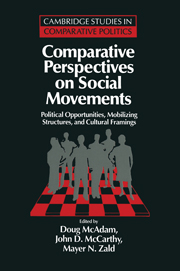 Comparative Perspectives on Social Movements
Comparative Perspectives on Social Movements Book contents
- Frontmatter
- Contents
- Biographical sketches of contributors
- Preface
- Introduction: Opportunities, mobilizing structures, and framing processes – toward a synthetic, comparative perspective on social movements
- PART I POLITICAL OPPORTUNITIES
- 1 Conceptual origins, current problems, future direction
- 2 States and opportunities: The political structuring of social movements
- 3 Social movements and the state: Thoughts on the policing of protest
- 4 Opportunities and framing in the Eastern European revolts of 1989
- 5 Opportunities and framing in the transition to democracy: The case of Russia
- PART II MOBILIZING STRUCTURES
- PART III FRAMING PROCESSES
- Notes
- References
- Index
1 - Conceptual origins, current problems, future direction
Published online by Cambridge University Press: 05 June 2012
- Frontmatter
- Contents
- Biographical sketches of contributors
- Preface
- Introduction: Opportunities, mobilizing structures, and framing processes – toward a synthetic, comparative perspective on social movements
- PART I POLITICAL OPPORTUNITIES
- 1 Conceptual origins, current problems, future direction
- 2 States and opportunities: The political structuring of social movements
- 3 Social movements and the state: Thoughts on the policing of protest
- 4 Opportunities and framing in the Eastern European revolts of 1989
- 5 Opportunities and framing in the transition to democracy: The case of Russia
- PART II MOBILIZING STRUCTURES
- PART III FRAMING PROCESSES
- Notes
- References
- Index
Summary
Writing in 1970, Michael Lipsky (1970: 14) urged political analysts to direct their attention
away from system characterizations presumably true for all times and all places… We are accustomed to describing communist political systems as “experiencing a thaw” or “going through a process of retrenchment.” Should it not at least be an open question as to whether the American political system experiences such stages and fluctuations? Similarly, is it not sensible to assume that the system will be more or less open to specific groups at different times and at different places?
Clearly Lipsky felt the answer to both questions was yes. He assumed that the ebb and flow of protest activity was a function of changes that left the broader political system more vulnerable or receptive to the demands of particular groups. Three years later Peter Eisinger (1973: 11) used the term “structure of political opportunities” to help account for variation in “riot behavior” in forty-three American cities. Consistent with Lipsky's view, Eisinger (1973: 25) found that “the incidence of protest is … related to the nature of a city's political opportunity structure,” which he defined as “the degree to which groups are likely to be able to gain access to power and to manipulate the political system.”
Within ten years the key premise informing the work of Lipsky and Eisinger had been appropriated as the central tenet in a new “political process” model of social movements. Proponents of the model (e.g., Jenkins and Perrow, 1977; McAdam, 1982; Tarrow, 1983; Tilly, 1978) saw the timing and fate of movements as largely dependent upon the opportunities afforded insurgents by the shifting institutional structure and ideological disposition of those in power.
- Type
- Chapter
- Information
- Comparative Perspectives on Social MovementsPolitical Opportunities, Mobilizing Structures, and Cultural Framings, pp. 23 - 40Publisher: Cambridge University PressPrint publication year: 1996
- 453
- Cited by


